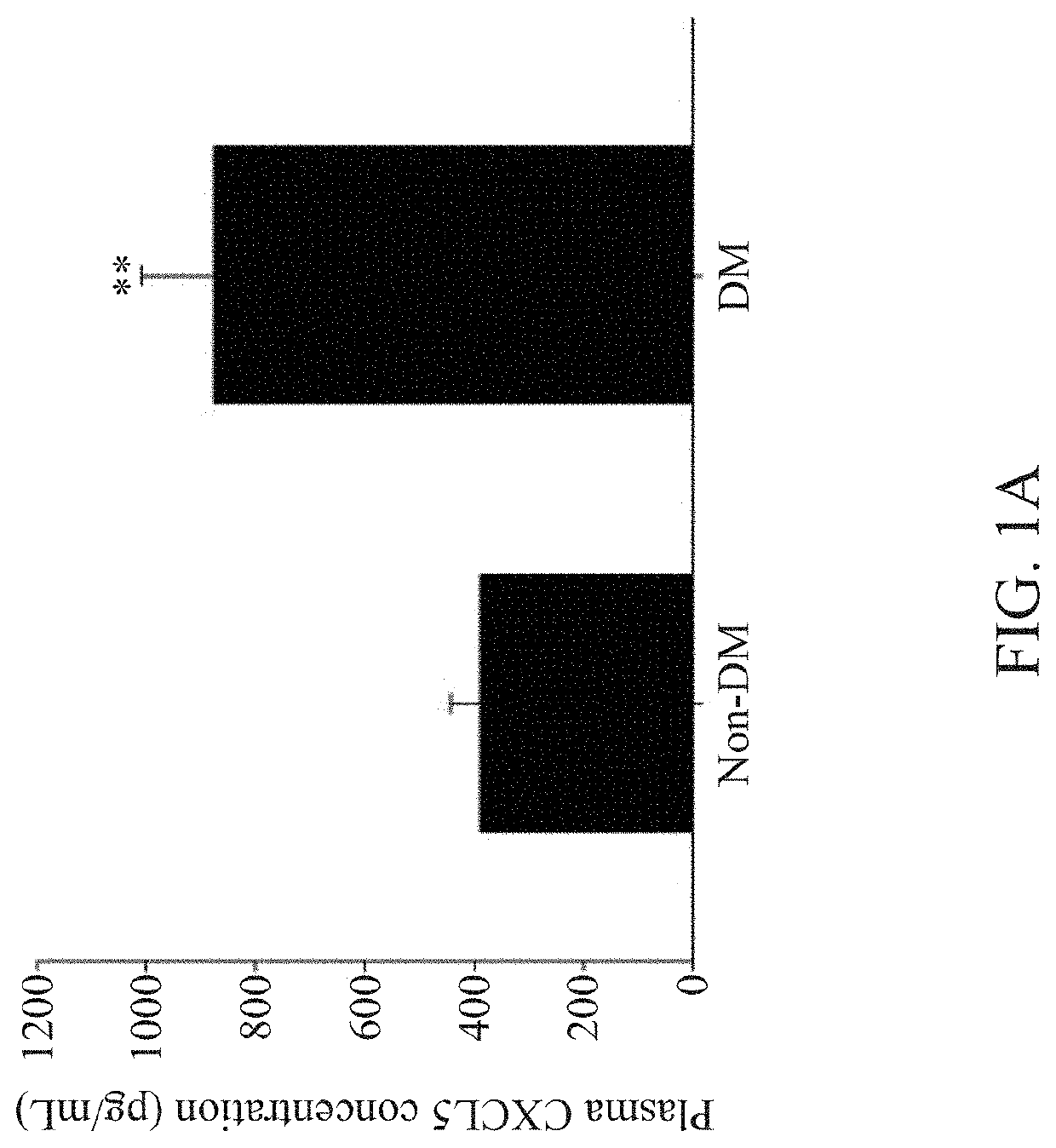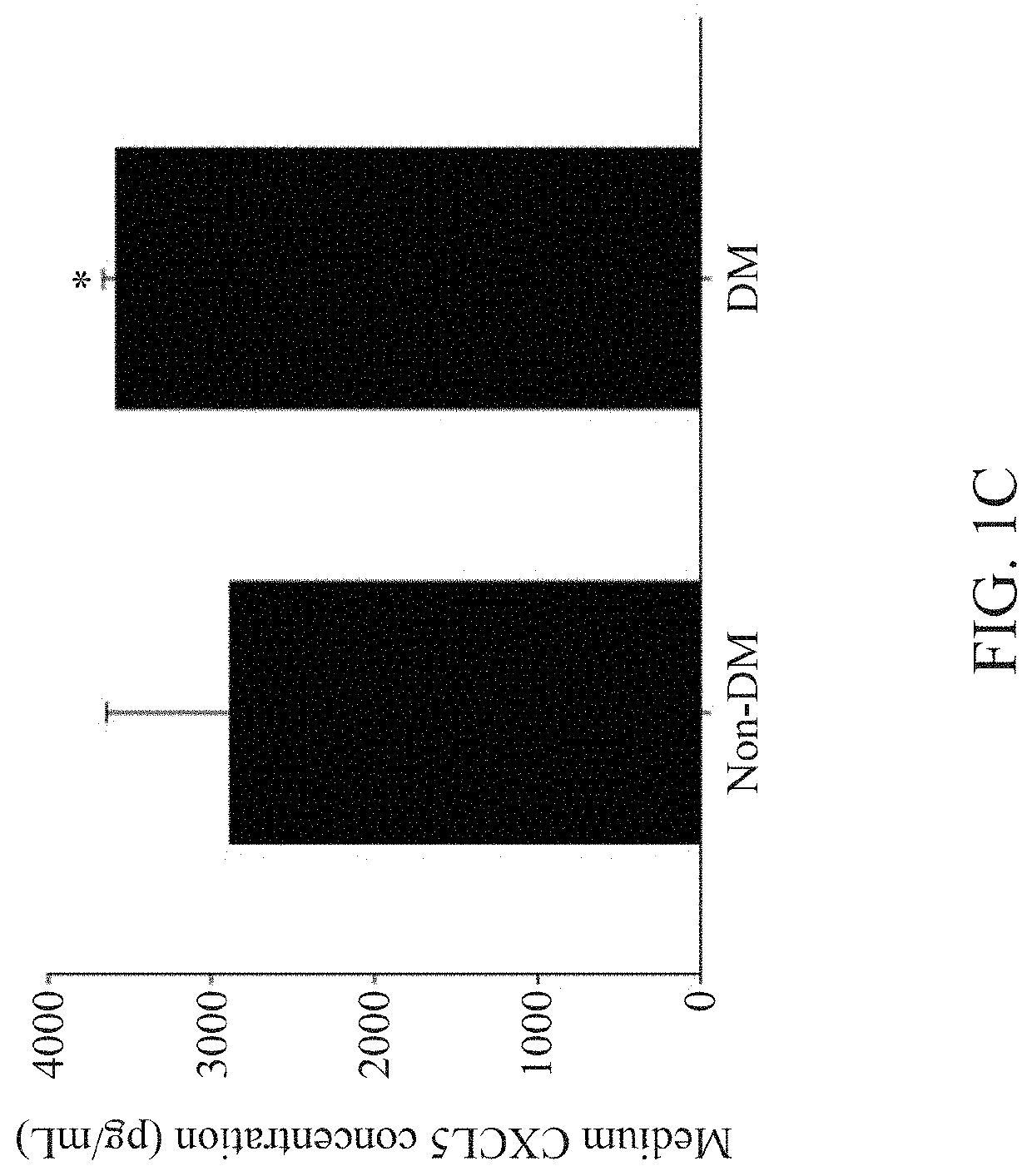Method for preventing or treating peripheral arterial occlusive disease
a technology of peripheral arterial ischemia and ischemia, which is applied in the field of preventing or treating peripheral arterial ischemia, can solve the problems of further ulceration, reduced patient's mobility, and necrosis of the area, and achieves the effects of improving the function of endothelial progenitor cells, enhancing angiogenesis, and improving the healing ability of wounds and ischemia
- Summary
- Abstract
- Description
- Claims
- Application Information
AI Technical Summary
Benefits of technology
Problems solved by technology
Method used
Image
Examples
example 1
nts of CXCL5 Levels in Plasma and Endothelial Progenitor Cells (EPCs)
[0072]For cell culture of EPCs, blood samples were obtained from the peripheral veins of healthy volunteers or patients with type 2 diabetes mellitus (DM) in the morning hours after an overnight fasting. In this study, only stable type 2 DM patients without insulin treatment were enrolled, and patients with other significant systemic diseases, receiving major operation in the past 6 months, or currently under medical treatment for other diseases were excluded. The human study was approved by the institute research committee and conformed with the Declaration of Helsinki.
[0073]After blood sampling, the total mononuclear cells were isolated by density gradient centrifugation with Histopaque-1077 (1.077 g / mL, Sigma-Aldrich). In brief, mononuclear cells were plated in endothelial cell growth basal medium-2 (EBM-2; Lonza), with supplements (hydrocortisone, human fibroblast growth factors, vascular endothelial growth fac...
example 2
CXCL5 Neutralizing Antibody on the Functions of EPCs
[0075]EPCs were obtained by the process described in Example 1. Further, EPCs from healthy volunteers were cultured in high glucose (25 mM) for 3 days to obtain high glucose-stimulated EPCs. EPCs (1×104 cells) from healthy volunteers and DM patients were individually resuspended in serum-free EBM-2 after pretreatment with CXCL5 monoclonal antibody (1 ng / mL or 10 ng / mL; R&D Systems) or IgG control for 24 hours for the subsequent migration assay and tube formation assay.
[0076]The migration of EPCs was evaluated using a chamber assay. The pretreated cells were added to the upper chambers of 24-well transwell plates with polycarbonate membranes. EBM-2 supplemented with 10% fetal bovine serum was added to the lower chamber. After incubation for 18 hours, the cells were fixed with 4% paraformaldehyde and stained using a hematoxylin solution. The numbers of migrated cells were counted in six random high-power (×100) microscopic fields.
[00...
example 3
CXCL5 Neutralizing Antibody on Human Aortic Endothelial Cells (HAECs)
[0081]Primary HAECs (ScienCell, Carlsbad, Calif., USA) were cultured in fibronectin-coated plates with endothelial cell medium containing 5% fetal bovine serum, 1% endothelial cell growth supplement, and 1% penicillin / streptomycin solution at 37° C. in a humidified incubator with an atmosphere of 5% CO2. The evaluations of the angiogenesis and migration abilities of HAECs and the VEGF and SDF-1 expressions in HAECs were performed according to the processes described in Example 2.
[0082]The results were shown in FIGS. 4A to 4G. It was observed that CXCL5 neutralizing antibody induced a significantly greater angiogenic response in the high glucose-stimulated HAECs by signaling through VEGF and SDF-1 pathways.
PUM
| Property | Measurement | Unit |
|---|---|---|
| diameter | aaaaa | aaaaa |
| thickness | aaaaa | aaaaa |
| length | aaaaa | aaaaa |
Abstract
Description
Claims
Application Information
 Login to View More
Login to View More - R&D
- Intellectual Property
- Life Sciences
- Materials
- Tech Scout
- Unparalleled Data Quality
- Higher Quality Content
- 60% Fewer Hallucinations
Browse by: Latest US Patents, China's latest patents, Technical Efficacy Thesaurus, Application Domain, Technology Topic, Popular Technical Reports.
© 2025 PatSnap. All rights reserved.Legal|Privacy policy|Modern Slavery Act Transparency Statement|Sitemap|About US| Contact US: help@patsnap.com



